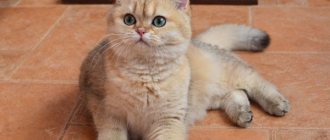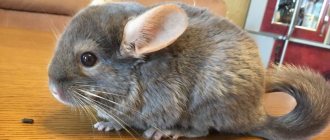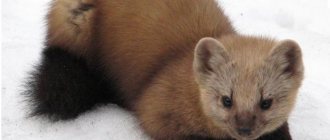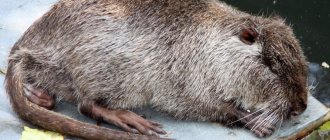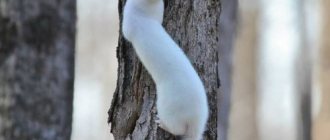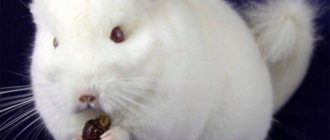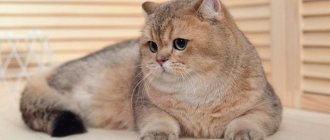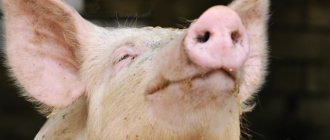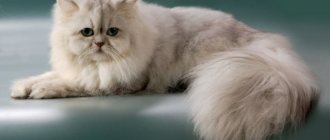08 December98190pet rodentschinchilla
The chinchilla animal is a rodent that inhabits the territory of South America. Chinchillas are known for their valuable fur, because of which their numbers have rapidly decreased and these animals are listed in the Red Book. Today the chinchilla animal is a very popular pet. Below you will find a description of the chinchilla, and you can also learn about the features of caring for and keeping a chinchilla at home.
Description of chinchilla
The chinchilla looks very cute and funny. The chinchilla animal has a large head, short neck and round body. She has large ears, a long mustache and a short tail. The chinchilla looks like a small rodent. Chinchillas range from 25 to 35 cm in length, with females being larger than males. The rodent weighs 500-700 grams.
The chinchilla looks fluffy, as if made of plush. She has soft, thick and beautiful fur. The chinchilla looks inconspicuous due to its gray-blue color and only on its belly its fur has a light gray tint. Modern colors of captive-bred chinchillas are varied and have many variations.
The description of the chinchilla includes many unusual facts about these rodents. For example, their ears have special membranes, with the help of which the animals close their ears during sand baths so that sand does not get inside. Chinchilla fur is very dense because up to 80 hairs grow from each hair follicle.
Thanks to the developed cerebellum, the chinchilla animal has good coordination and is adapted to night life. The animal's hind legs are longer than its front legs, which allows it to jump to a height of up to 2 meters. Chinchillas make many interesting sounds, they can quack, chirp, growl, squeak and click their teeth.
Chinchilla nutritional features
Chinchilla eats
Like other herbivorous rodents (for example, the spiny mouse), chinchillas feed on various plants, mainly cereals, as well as seeds, moss, lichens, shrubs, tree bark, and occasionally small insects. In captivity, chinchillas eat exclusively dried foods (for example, dried apples, carrots, hay, nettles and dandelion roots); special granules are used as the main food.
Where and how long do chinchillas live?
Chinchillas live for about 20 years. The homeland of these animals is South America. Under natural conditions, the chinchilla lives in the Andes of Southern Bolivia, northwestern Argentina and northern Chile. Chinchillas live in the mountains at an altitude of up to 5 km above sea level. In its natural environment, the chinchilla animal lives in rock crevices, under stones, or digs holes.
The chinchilla animal is perfectly adapted to life in the mountains. The structure of the skeleton allows the animal to crawl through even the narrowest spaces, and the developed cerebellum ensures confident movement along rocks. Chinchillas live in colonies and are active at night. In nature, chinchillas feed on various herbaceous plants (cereals, beans, mosses, lichens, shrubs, cacti, tree bark) and insects.
The chinchilla animal is mostly monogamous. Chinchillas become capable of reproduction at the age of 7-8 months. The duration of pregnancy is a little more than 3 months. Usually 2-3 babies are born. The female is capable of bearing offspring up to three times a year. Chinchilla cubs are born with open eyes, erupted teeth and covered with primary hair.
It's no secret that the chinchilla animal is a source of valuable fur. Chinchillas began to be hunted for their beautiful fur in the 19th century. To make one fur coat, it takes about a hundred skins, so chinchilla fur products are rare and expensive. In 1928, a coat made from the fur of these rodents cost half a million gold marks. In 1992, the price of a chinchilla fur coat was $22,000. Currently, the chinchilla animal is protected in South America. Now in many countries there are special farms where chinchillas are bred for their fur.
Chinchilla is an extremely profitable animal. Anti-crisis program
Keeping chinchillas today may well become a profitable business for a farmer, a pensioner, a schoolchild, a student, and even for people with disabilities.
Chinchilla cages
The size of the cage for keeping a pair of adult animals with offspring is 50x50x50 cm. As a room for keeping, you can use a room in the house or a dry, well-ventilated room in an outbuilding.
The windows of a room with a large number of cells should face east or west, and rows of cells should be installed along the windows so that they are all equally illuminated. It is important to cover the windows with insect screens to keep flies out.
Breeding conditions
The room temperature should be maintained at +18-20°C, although the chinchilla easily tolerates low temperatures and feels good in a dry room at temperatures just above zero. High humidity at low temperatures contributes to the development of fungal diseases, decreased fertility, increased feed consumption and, in extreme cases, leads to mortality.
Chinchilla does not like sharp, unexpected sounds. Animals react to them with increased nervousness, aggression, and periodic infertility. The animals quickly get used to constant monotonous sounds and noises.
The main equipment of the cages are glass or ceramic bowls and glasses; they are heavy, they are not so easy to turn over, and animals do not chew them.
Food for chinchillas
The chinchilla is a herbivore; in natural conditions it is content with very poor plant food, which is dry for most of the year. Therefore, on farms, their feeding is based on dry feed - this is hay, as well as cereals in the form of corn, wheat, and Hercules oat flakes. Dry twigs of apple, willow, willow, rose hips and hawthorn.
Reproduction
Chinchilla is a polygamous animal. In the wild, there are from three to seven females per male. When keeping cages, it is best to keep chinchillas in pairs (one male + one female). With this type of maintenance, after the birth of the puppies, there is no need to remove the male from the cage. Within a week after the birth of the offspring, the female mates with the male.
Chinchillas reproduce slowly compared to, say, rabbits. It is believed that under optimal housing conditions, one average female can produce 3-5 chinchillas per lamb, up to three times a year. Pregnancy in chinchillas lasts, on average, 105-117 days.
Business areas
There are two main directions for selling chinchilla products. The first and most profitable is the sale of animals from 2 to 6 months for further breeding. The result is a profitability of up to 50%. The second is the sale of live chinchillas for skins (from 6 months to 18-20 years). Selling animals for skins allows us to confidently make a profit of up to 60%. Hence the conclusion that selling chinchillas for skins is economically profitable and profitable.
The sale of live animals for breeding purposes is the main business for fur farmers in Russia for the next 20 years, and sales for skins is a related business. Both directions have already been mastered by thousands of chinchilla breeders from different countries, and it’s up to chinchilla breeders from Russia.
Chinchilla was taken from us not only throughout Russia, but also in Azerbaijan, Armenia, Georgia, Turkey, Kazakhstan, Uzbekistan, Turkmenistan, Iran. But, as in any other type of business, it is necessary to conduct business more skillfully and carefully.
Subtleties of business
Here are just a few real examples showing how easy it is to get caught in the cunningly arranged networks of chinchilla dealers in our time.
Recently, young enterprising people from Kazakhstan and Kyrgyzstan called me and offered to develop their market, explaining that they are located next to China and supplying animals to this country is very profitable and profitable. A tempting offer?
But let's think a little: this country has a population of one and a half billion, and since 2015 families are allowed to have not one child, but two, that is, the population will double. The standard of living in the Middle Kingdom cannot possibly be higher than in Russia.
What kind of chinchillas are there - here you need to think about your daily bread. Everyone also knows that chinchillas are brought to us from China, and not vice versa. I will simply lose money and time establishing chinchilla trade with China.
At the beginning of January 2016, a call came from Crimea. Farmers called who managed to purchase a batch of breeding chinchillas in Sevastopol and they would like to sell the animals for fur coats in Russia, since the border with Ukraine is closed and there is no longer any sale of “fallow” chinchillas.
I tried to explain to them that chinchilla was brought to us and is now being imported mainly from Ukraine, from Lvov. This is a chinchilla that was subject to so-called close crossing, and it is not suitable for skin at all. Everything that was once brought from Lvov now goes along established routes to Crimea and Sevastopol.
After all, before a chinchilla is slaughtered for its skin, it is left indoors for 45 days, where it is alone in a cage. It is bathed in baths with sand and talc to give the skin shine and cleanliness. The air temperature from 23°C is lowered to 3-4 degrees within 45 days, and only then the slaughter and subsequent dressing of the skin are carried out using electric shock and other exotic types of slaughter.
This is a very, very labor-intensive process. And the chinchilla, where close crossing was allowed, especially in the regions of western Ukraine, will not withstand a drop in temperature for 45 days. And, as the Russians say, it will quickly “glue its fins together” and most of the livestock will not live to see slaughter. That is why it is necessary to take a chinchilla from large or medium-sized nurseries, so that this chinchilla can then be quickly sent for skinning.
Finding a free niche for business
In modern economic conditions and the market as a whole, to start a business you need to look for unoccupied production niches. One of these is chinchilla breeding. Let's try to figure out what's what and what's required for this. To do this, we will consider a ready-made business plan, as well as the conditions for their maintenance and breeding at home.
As you know, the chinchilla is a fur-bearing herbivore animal, which, subject to certain conditions, can be kept in latitudes from the city of Sochi to the cities of Norilsk and Magadan. Chinchillas are kept as a pet (for children, in pet corners, offices, and so on).
Organization of a mini-farm
You can organize a mini-farm for breeding chinchillas “Mini-farm for breeding chinchillas for 6 pairs of adult chinchilla animals” on the glassed-in balcony of a 17-story building. So, on the eleventh floor of an 11-story residential building in Taganrog, pensioners in one room and on the balcony keep 80 pairs of adult chinchilla animals.
An adult eats 8–12 kg per year. stern. It is necessary that there is always water in the cage and that the cage is cleaned and cleaned once every two weeks, and that the entire cage is disinfected once every 2–3 months.
For a starting business, you need to try breeding with 6 pairs (12 individuals) of adult animals. Let’s say you have acquired 6 families, you are going to raise a chinchilla in a house, apartment, barn, garage or greenhouse, in your own premises, saving on rent. The chinchilla is fed once a day, and it will take you only 10 - 15 minutes a day. One breeding individual costs, depending on age, from 3,500 to 4,500 rubles. Chinchillas live 15–21 years, and reproduce very well until they are 9–12 years old.
You can make cells yourself, on your own (there’s nothing complicated about it). 12 chinchillas X 4,500 rubles = 54,000 rubles – the cost of purchasing a chinchilla. A chinchilla breeds 3 times a year and produces an average of 2–4 offspring. It turns out 9 animals from one pair: 9X6 = 54 animals. 54 chinchillas, if sold at 2-3 months of age, then one animal costs 2,000 rubles. If at 6 months of age - 3,500 rubles. If with a pregnant female at 1 - 3 - 4 years of age - it costs 4,500 rubles per animal.
Everyone must calculate for themselves how many animals they can support. I will say, for example, that a year ago in Rostov-on-Don a young family bought 6 pairs of chinchillas. During the year they earned 240,000 rubles in net profit. The young chinchilla they had from lambing 1 and 2 also brought small chinchilla animals. These fluffy animals with very valuable fur are more profitable than rabbits, since there is practically no mortality, like in rabbits, they do not need to be fed with meat, like a sable, ferret or mink. A chinchilla takes up very little space and requires no upfront costs.
Cages for keeping chinchillas in pairs (when sold, we give each family free of charge, as well as an author’s book on breeding and keeping animals). At the moment, during the crisis, many people who worked with mushrooms, quails, rabbits or nutria are switching to chinchilla breeding. Very low feed consumption and no costs for large premises and paddocks once again prove the effectiveness and economic benefits of breeding and selling chinchillas.
In conclusion, I would like to emphasize that we do not have any representatives in the regions; we work directly, without intermediaries. If in any Russian region someone claims that they represent our interests, you should know that they are scammers. I will send the author’s book “Chinchilla – a super-profitable animal” for free to everyone who wants it. Anti-crisis program."
Director of the Breeding Nursery “Chinchilla Breeding in the Family Estate” Yu.I. Kharchuk, Krasnodar region, Tel.1, e-mail
How to tame a chinchilla?
It is better to get a chinchilla when the animal is no more than 2-3 months old. At this age, the animal quickly adapts to a new environment than older individuals. If you decide to get a chinchilla, remember that this is a nocturnal animal that will be active in the evening and at night. The first time after the animal appears in the house, give it a few days of rest so that it gets used to its new home.
Taming a chinchilla is not that easy. For the most part, chinchillas do not need much attention and communication with their owner. Therefore, a chinchilla should be tamed gradually. Try giving your pet a treat, open the cage door and hand the chinchilla something tasty. The pet will definitely take the treat from your hands, if not immediately, then after a while. The main thing is not to try to forcibly pick up the animal.
To tame a chinchilla you will need patience, calmness and a caring attitude. Soon the tamed animal will be safely in your arms or sitting on your shoulder. Remember that by nature the chinchilla is a gentle, timid creature and does not like loud noises. Be careful when handling your chinchilla and do not frighten it.
Chinchilla behavior
Chinchilla at home
Chinchillas are colonial animals that lead an active nocturnal lifestyle. The rodent's skeleton is capable of compressing in a vertical plane, which allows it to fit into the narrowest vertical crevices in rocks. Large black eyes, long whiskers and large ears are also adaptations to a nocturnal lifestyle.
What to feed your chinchilla?
Chinchillas are vegetarians, so when choosing food, you should take this feature of the animal into account. The chinchilla needs to be fed with special food. Pet stores have a huge range of granulated food. This food contains essential vitamins and minerals.
In addition to food, you must feed your chinchilla hay. You can prepare it yourself; for this you need to collect clover, dandelions and herbs. But you can also buy hay at a pet store. When purchasing, pay attention to the quality of the hay; it should be dry, clean, free of unpleasant odor and mold. A special hay feeder should be placed in the cage.
The chinchilla should be fed once a day. Food and water should always be fresh. Water should be given filtered or boiled. There should always be a special stone in the cage for grinding teeth, which can be purchased at any pet store.
Pelleted dry food and hay are the best diets for chinchillas. As a top dressing, you can give your chinchilla flax seeds, corn grains, dandelion leaves, birch, willow, raspberry, apple, currant and linden branches. But under no circumstances give branches of cherry, oak and coniferous trees. You should not feed your chinchilla many fresh vegetables and fruits, as this can lead to stomach problems.
Chinchillas especially love raisins, dried apricots, dried apples, pears, cherries and rose hips. But such treats should not be given often. Also be careful with nuts and seeds, they should be given in very limited quantities and only raw; fried grains are contraindicated for the animal. You should not give your chinchilla food from your own table (bread, cookies, etc.).
Common types of chinchilla
Short-tailed chinchilla (Chinchilla chinchilla or Chinchilla brevicaudata)
Short-tailed chinchilla
It is found under the names Bolivian, Peruvian and royal chinchilla. The species is endangered because it was actively exterminated for fur. Its natural range is the Chilean-Argentine Andes, Peru and Bolivia. Body length is from 30 to 38 cm, weight is from 500 to 800 g. The neck and shoulders are thick, the tail is shorter than that of the long-tailed chinchilla.
Long-tailed chinchilla (Chinchilla lanigera)
Long-tailed chinchilla at the Wroclaw Zoo
A very rare species in the wild that lives in the highlands of the Andes in Chile. It is distinguished by a long fluffy tail and long whiskers, which help the rodent navigate in the dark and find food. The fur is long, thick, up to 4 cm in length, with 60-70 hairs coming out of one hair follicle. Body length is from 20 to 40 cm, ears are about 6 cm long, whiskers reach 10 cm. The weight of males is from 370 to 500 g, the weight of females is from 380 to 450 g.
Care and maintenance of chinchillas at home
Keeping a chinchilla at home is no less popular than keeping a guinea pig. First of all, to keep a chinchilla you will need a spacious cage. It is better if the cage is of a tower type. The optimal solution in this case would be a display case for a chinchilla, which will be an excellent home for the animal and will fit well into the home interior. A display case for a chinchilla will satisfy all the needs of a rodent; it has a house, stairs, floors, balconies, a running wheel and other toys. In addition, cleaning in such a display case is even easier than in a cage.
Keeping a chinchilla requires maintaining a certain temperature. The chinchilla animal does not tolerate heat well, so the cage should be placed in a cool place, without direct sunlight and drafts. The optimal temperature for keeping a chinchilla will be +20-22 °C. At temperatures of +25 °C and above, the rodent will overheat. Never place the cage near batteries.
The bottom of the cage must be lined with sawdust or special filler. The animal goes to the toilet anywhere and it is very difficult to train a chinchilla to do it in one place. The litter will have to be changed at least once a week. It is better to hang the feeder and water bowl, otherwise the chinchilla may turn them into a toilet.
Caring for a chinchilla at home includes taking care of the rodent's coat. Chinchilla fur gets dirty very quickly, so the animal needs frequent hygiene procedures. But the chinchilla bathes not in water, but in special sand. Chinchillas take sand baths with diligence and sand will fly in all directions. Therefore, it is advisable to carry out this procedure outside the cage, so as not to collect sand later. The best option in this case would be a round aquarium or any other deep, stable, round-shaped container. Place it on the floor, lay newspaper under it, pour a 5-6 cm layer of sand on the bottom and put the animal there for 20-30 minutes.
Caring for a chinchilla at home includes bathing at least 2 times a week. If your home has high humidity and temperatures close to +25 °C, bathing should be done 3 times a week. Bathing is a must for an animal if you want your chinchilla to have beautiful fur. Do not forget that swimming in water is harmful to a chinchilla and will cause health problems.
Also remember that ordinary sand (sea, river) is not suitable for swimming. After all, in the wild, the chinchilla animal bathes in volcanic dust, and not in sand. Therefore, at home it is permissible to use only special sand. In addition, in ordinary sand, an animal can become infected with fungus, parasites or skin diseases. To prevent skin diseases, antifungal drugs can be added to special sand.
In general, caring for and maintaining a chinchilla at home does not require much effort. The main condition is to protect the animal from overheating and maintain the correct diet. Try not to leave the animal unattended outside the cage. Remember that rodents love to taste everything and you will be guaranteed damaged furniture. The main danger lies in electrical wires. Also, do not forget that any hard-to-reach space in the apartment will be immediately explored by a curious animal.
The chinchilla, the maintenance and care of which is quite simple, has a number of advantages and one disadvantage. The advantages include the small cost of the animal, beautiful appearance, lack of odor and shedding, and peaceful character. But the disadvantage is the nocturnal lifestyle. If you decide to get such an animal, you will have to get used to rustling, squeaking and fussing at night.
Chinchilla protection
Nowadays, only in Chile can you find this animal living in the wild, but the number of these animals is constantly declining. Scientists have been able to roughly estimate that no more than 10 thousand individuals remain in nature. In this regard, in 2008, the chinchilla was listed in the International Red Book, under the status of “endangered species”.
Zoological specialists have repeatedly made attempts to resettle animals to other territories, but all these attempts have been in vain. The chinchilla refused to live in other, even more comfortable living conditions. The total number of these animals is decreasing due to some negative factors, such as environmental degradation and ongoing poaching.
Even in a nightmare one cannot dream that the populations of these animals have decreased from several tens of millions to several thousand. Unfortunately, it couldn't have happened without people. The chinchilla is a cute animal that does not show any aggression. Moreover, these are animals that can bring a person a lot of positive emotions. Being in captivity, these animals are able to keep company for any person. Unfortunately, man has never been able to become a true friend and defender of wildlife, despite the fact that he has every opportunity.
Pet chinchillas
Domestic chinchilla in a cage
Breeding chinchillas in captivity has been practiced since the beginning of the twentieth century, when the population of this valuable animal decreased significantly. Chinchillas are also kept as a pet.
Chinchillas are kept in pairs, separating only 7-10 days before the babies are born. A cage with a metal frame is used as housing. The floor of the cage is covered with hay, sawdust and sand, in which the animals bathe. The room temperature should be about 20°C, humidity 45-60%. The cage is cleaned and disinfected 1-2 times a week.
Chinchillas are unpretentious when it comes to food. They are fed plant foods, concentrated (legumes, grains, seeds) and green, and mineral supplements and hay are also included in the diet. The daily amount of hay is 25 g. In winter, chinchillas are fed carrots. Babies and lactating females are fed oatmeal and oatmeal-based milk formula.
The chinchilla's fur is inspected and combed if necessary. When animals live in pairs, they take care of each other.
To feel good, chinchillas need sand and dust baths, after which their fur becomes fluffy and shiny. Baths are made from sifted sand (up to 95%) and talc.
Chinchilla breeding
Cute baby chinchillas
Chinchillas are monogamous animals. A female's pregnancy is determined by an increase in her weight, which grows by 100-110 g every 15 days. As the birth approaches, the female practically does not eat or move. One litter contains from 1-2 to 5-6 cubs. Babies are born in fluff, with teeth and open eyes. Literally immediately after birth, they can move independently. The weight of newborns is from 30 to 70 g. A female can bear up to 3 litters per year. Feeding the babies lasts from 45 to 60 days, after which the chinchillas are removed. The young grow quickly, weight at the age of 1 month reaches 114 g, at 60 days about 200 g, at 90 days up to 270 g, at 120 days more than 300 g.


